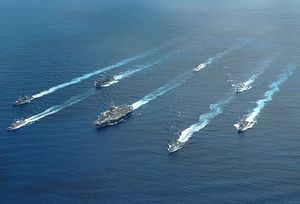Harry Kazianis recently sought to refute an article I wrote for The Diplomat criticizing Air-Sea Battle (ASB). In his response to my article, Kazianis argued 1) ASB is misunderstood; 2) ASB is not about China; 3) ASB has other ways to defeat A2/AD than relying on long-range strikes against ballistic missile launchers, radar sites, and command and control (C2) networks; and 4) A blockade against China, which I had proposed as an alternative to ASB, doesn’t work for countries other than China. Some of these critiques are eminently fair; others are less so.
First: is ASB misunderstood? Is ASB really not about China? These arguments are predicated on the notion that both the Department of Defense and prominent defense think tanks have done a poor job of explaining the operational concept. As General Hoss Cartwright put it: “To some, [ASB is] becoming the Holy Grail…[But] it’s neither a doctrine nor a scenario and it’s trying to be all things to all people.” According to this argument, ASB is about perfecting basic “blocking and tackling” in a joint operational space, the aspects that most assumed the U.S. military could execute successfully but in reality has allowed its capabilities to wane in.
One such example of this, as highlighted by Sam LaGrone, was when a P-3 Orion ASW aircraft and an A-10 Thunderbolt II were jointly controlled by a U.S. destroyer to mop up Libya’s small coastal forces during Operation Odyssey Dawn. Neither aircraft normally works with the other: one hunts submarines; the other takes out tanks and conducts close air support missions. But they were the assets that were on hand, and they effectively eliminated the threat. In the future, the ASB office could advise the services in how to improve these kinds of ad-hoc operations.
Let me state unambiguously: I support such operations. Many of these examples (like making sure U.S. cyber networks are secure and can maintain ISR or logistics in a contested space) are defensive in nature and are just good common sense. Joint C2 has a wide variety of applications and is one of the great force multipliers of the U.S. military. Hunting submarines and clearing mines are a vital capability that shouldn’t be allowed to wither away. These are all operations that could be particularly useful in a military conflict with China or Iran, but they are not specifically aimed at China or Iran.
But then we get back to long-range strikes. Mr. Kazianis contends that long-range strikes on the Chinese mainland are but one option among many that the U.S. could use in an “escalation dominance” ASB framework, and that “it seems silly to dismiss ASB outright as escalatory based on one possible use of the concept.” This is an insufficient rebuttal. Eliminating adversaries’ central weapon systems through the use of penetrating strike assets—such as cruise missiles fired from a Virginia-class submarine with an enhanced payload module, smart bombs dropped from a Long-Range Strike Bomber (LRS-B), or Conventional Prompt Global Strike (CPGS)— is a central component of ASB.
In fact, this is acknowledged by the Joint Operational Access Concept (JOAC) and the Air-Sea Battle Office’s May 2013 report, both of which refer to such strikes as “attack-in-depth.” As the JOAC puts it:
“The potentially escalatory effects of strikes into an adversary’s homeland must be carefully weighed against U.S. political objectives and acceptable risk. Such escalation is particularly likely when the conflict is distant from the US homeland, and there has been no corresponding attack on U.S. territory. In these cases, the probability and risk of reprisal attacks against the continental United States must be considered.”
My argument is that the political risk vis-à-vis China will, under any reasonable scenario, always be too high; no president, unless faced with an existential threat, will authorize these kinds of strikes against the Chinese mainland.
Furthermore, as Matthew Hipple argued in a recent War on the Rocks article, a U.S.-China war would most likely start in situations “not where strategic interests bring [the] parties into conflict, but where tactical and operational level controls are accidentally engaged and rational escalatory responses are executed.” I agree that unintentional escalation is far more likely than a premeditated, first strike that leads to total war. In this situation, the U.S. would want to deescalate the war and slow down the tempo of operations, not significantly escalate the situation. A blockade would meet such objectives.
ASB does the opposite: it assumes that the U.S. will be subjected to a surprise attack, and that U.S. forces must provide an “immediate and effective response” through “high-tempo operations” to disrupt enemy A2/AD capabilities. ASB supporters, however, claim that the U.S. could control the level of escalation. But, as Hipple points out, “interest and intention are often overwhelmed by circumstance and procedure.” It is not really the development of strike capabilities itself that makes ASB dangerous; it is the way in which such capabilities would be used in a potential war. JOAC warns of the risks of a strike on an adversaries’ homeland, but does not even consider that the national command authority may be unable to rationally assess the risks of escalation. The question becomes: will war between the U.S. and China begin like World War I or World War II? A random event that leads to uncontrollable escalation, or a premeditated first strike? I would strongly argue the former.
It is entirely possible that penetrating strike assets might have utility in other scenarios such as North Korea or Iran, both of which have advanced air defense networks. Similarly, I don’t doubt that a blockade might prove useless against relatively isolated countries like North Korea or Iran. But if the U.S. is developing long-range strike capabilities for these adversaries and not China, this needs to be stated explicitly.

































